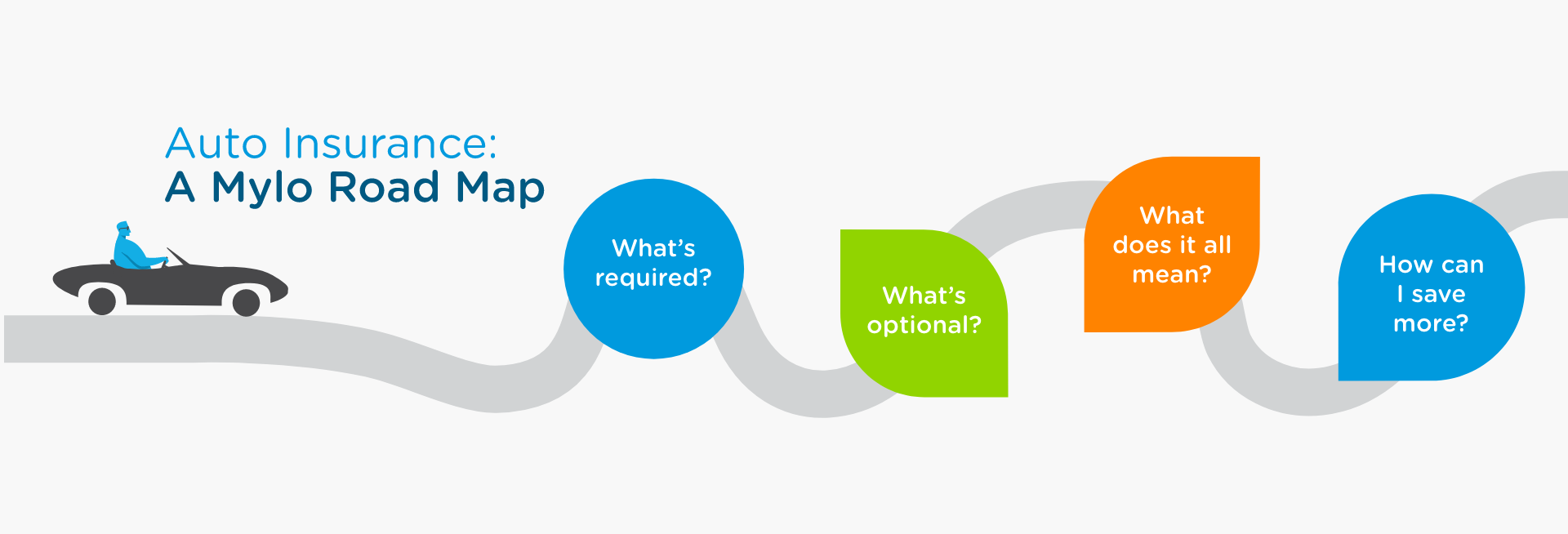
Whether you’re heading to work, hitting the highway or chauffeuring the kids to their million (and one) activities, you want peace of mind behind the wheel. We're ready to help you with that! We’ve also put together this handy guide to steer you to coverage that makes sense for you.
What auto coverage do I have to carry?
If you drive a vehicle, all states require you to cover Liability coverage for any harm you may cause:
- Bodily Injury Liability.
Covers
you for damages your vehicle
may cause to other people
- Property Damage Liability. Covers you for damages your vehicle may cause to others’ property
What coverage is optional but (usually) recommended?
Depending on your budget, vehicle and driving habits, some or all of these can be good ideas for protecting yourself. A licensed Mylo agent can help you find the right combo:
- Collision. Covers damages caused to your vehicle if it collides with something, whether or not you’re at fault. Exceptions: can’t be any kind of animal or a flying object (like hail) or if your car is over 15 years old, it may not be worth carrying (ask your agent).
- Comprehensive. Covers most of the things Collision doesn’t (animals, hail, flood damage, even falling avocados), whether or not you’re at fault.
- Uninsured motorist. Covers damages to you and your vehicle if you’re struck by someone without insurance. If you’re struck by a hit-and-run driver, it covers injuries to you but not your vehicle.
- Underinsured motorist. Makes up the difference if you’re struck by someone without enough insurance to pay for the damages.
- Gap. Super affordable extra coverage that helps replace your car if it’s totaled, and you still owe more on your loan than the vehicle is worth.
Med Pay vs. PIP?
All states require agents to offer medical coverage. This doesn’t mean you have to purchase it. Depending on your state, you can carry either:
- Med Pay. Covers medical expenses to anyone injured in your car, whether or not you’re at fault.
- Personal Injury Protection (PIP). Covers medical expenses, loss of income, funeral expenses and other benefits to anyone injured in your car, whether or not you’re at fault.
What's up with the numbers?
You may have seen something like this on an auto insurance policy: 100/300/100
It’s not weird secret code (well, not secret anyway). It’s called a “split limit.” Untangling the terminology, a split limit means your Liability coverage has a maximum payout for Bodily Injury (per person and per accident) and Property Damage (per accident).
100/300/100 means no more than $100,000 is paid for one injured person, no more than $300,000 for all injured people in one accident, and no more than $100,000 for property damage. 100/300/100 is the most common split limit. Your agent can find what’s right for you.
Can I add more than one name to my policy?
You can add anyone within your household who has ownership of the car to your policy. However, your policy needs to have a primary policyholder—called the first named insured. This first person listed on your policy is the one who’s legally responsible for making payments and the only one who can:
- Cancel the policy
- Make changes in it
How exactly is my car valued?
If your vehicle is damaged or totaled in an accident, your Collision, Comprehensive, and/or Gap coverage will kick in. But policies differ in how they calculate the cost of fixing or replacing your car. It’s good to know which you have so you won’t be surprised.
- Actual Cash Value (ACV). Pays out the value of your vehicle and parts minus depreciation (value lost since your purchase).
- Functional Replacement Cost (FRP). Pays for like value—such as auto parts that functionally do the same thing as yours.
- Stated Value. For collector, antique and other expensive vehicles: you assign a value, but carrier can pay the Actual Cash Value if that’s lower.
- Agreed Value. Also for collector, antique and other expensive vehicles: You and your agent agree on the value upfront (can take more work on your part—an appraisal may be needed).
The road to savings
No matter what coverage you need, there are discounts you may not know about to keep your premiums affordable:
- Good student and safe driver discounts. Mylo can help you save good money for your good behavior
- Accident forgiveness. Some providers won’t raise your rates if you have your first accident after 5 years
- Home owner discount. You may qualify for a discount if you own (and insure) a house or condo
- Bundling discount. Enjoy sweet savings (and extra convenience) by bundling your home and auto coverage together